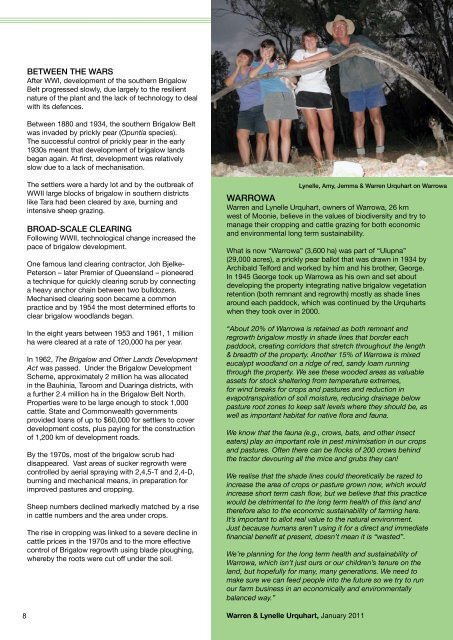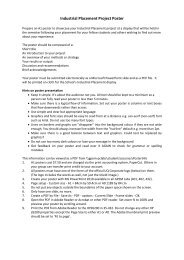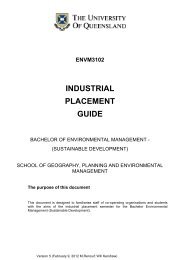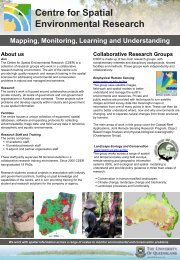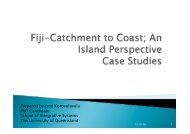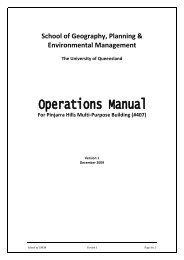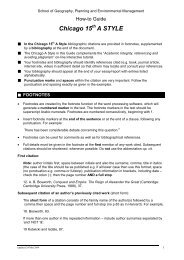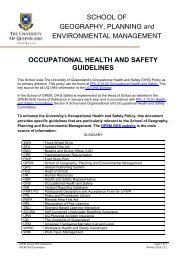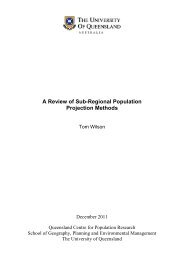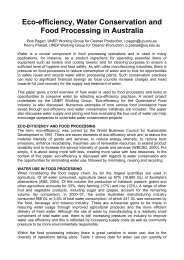Conserving Biodiversity in Brigalow Regrowth - School of ...
Conserving Biodiversity in Brigalow Regrowth - School of ...
Conserving Biodiversity in Brigalow Regrowth - School of ...
Create successful ePaper yourself
Turn your PDF publications into a flip-book with our unique Google optimized e-Paper software.
Between the Wars<br />
After WWI, development <strong>of</strong> the southern <strong>Brigalow</strong><br />
Belt progressed slowly, due largely to the resilient<br />
nature <strong>of</strong> the plant and the lack <strong>of</strong> technology to deal<br />
with its defences.<br />
Between 1880 and 1934, the southern <strong>Brigalow</strong> Belt<br />
was <strong>in</strong>vaded by prickly pear (Opuntia species).<br />
The successful control <strong>of</strong> prickly pear <strong>in</strong> the early<br />
1930s meant that development <strong>of</strong> brigalow lands<br />
began aga<strong>in</strong>. At first, development was relatively<br />
slow due to a lack <strong>of</strong> mechanisation.<br />
8<br />
The settlers were a hardy lot and by the outbreak <strong>of</strong><br />
WWII large blocks <strong>of</strong> brigalow <strong>in</strong> southern districts<br />
like Tara had been cleared by axe, burn<strong>in</strong>g and<br />
<strong>in</strong>tensive sheep graz<strong>in</strong>g.<br />
Broad-scale clear<strong>in</strong>g<br />
Follow<strong>in</strong>g WWII, technological change <strong>in</strong>creased the<br />
pace <strong>of</strong> brigalow development.<br />
One famous land clear<strong>in</strong>g contractor, Joh Bjelke-<br />
Peterson – later Premier <strong>of</strong> Queensland – pioneered<br />
a technique for quickly clear<strong>in</strong>g scrub by connect<strong>in</strong>g<br />
a heavy anchor cha<strong>in</strong> between two bulldozers.<br />
Mechanised clear<strong>in</strong>g soon became a common<br />
practice and by 1954 the most determ<strong>in</strong>ed efforts to<br />
clear brigalow woodlands began.<br />
In the eight years between 1953 and 1961, 1 million<br />
ha were cleared at a rate <strong>of</strong> 120,000 ha per year.<br />
In 1962, The <strong>Brigalow</strong> and Other Lands Development<br />
Act was passed. Under the <strong>Brigalow</strong> Development<br />
Scheme, approximately 2 million ha was allocated<br />
<strong>in</strong> the Bauh<strong>in</strong>ia, Taroom and Duar<strong>in</strong>ga districts, with<br />
a further 2.4 million ha <strong>in</strong> the <strong>Brigalow</strong> Belt North.<br />
Properties were to be large enough to stock 1,000<br />
cattle. State and Commonwealth governments<br />
provided loans <strong>of</strong> up to $60,000 for settlers to cover<br />
development costs, plus pay<strong>in</strong>g for the construction<br />
<strong>of</strong> 1,200 km <strong>of</strong> development roads.<br />
By the 1970s, most <strong>of</strong> the brigalow scrub had<br />
disappeared. Vast areas <strong>of</strong> sucker regrowth were<br />
controlled by aerial spray<strong>in</strong>g with 2,4,5-T and 2,4-D,<br />
burn<strong>in</strong>g and mechanical means, <strong>in</strong> preparation for<br />
improved pastures and cropp<strong>in</strong>g.<br />
Sheep numbers decl<strong>in</strong>ed markedly matched by a rise<br />
<strong>in</strong> cattle numbers and the area under crops.<br />
The rise <strong>in</strong> cropp<strong>in</strong>g was l<strong>in</strong>ked to a severe decl<strong>in</strong>e <strong>in</strong><br />
cattle prices <strong>in</strong> the 1970s and to the more effective<br />
control <strong>of</strong> <strong>Brigalow</strong> regrowth us<strong>in</strong>g blade plough<strong>in</strong>g,<br />
whereby the roots were cut <strong>of</strong>f under the soil.<br />
Lynelle, Amy, Jemma & Warren Urquhart on Warrowa<br />
Warrowa<br />
Warren and Lynelle Urquhart, owners <strong>of</strong> Warrowa, 26 km<br />
west <strong>of</strong> Moonie, believe <strong>in</strong> the values <strong>of</strong> biodiversity and try to<br />
manage their cropp<strong>in</strong>g and cattle graz<strong>in</strong>g for both economic<br />
and environmental long term susta<strong>in</strong>ability.<br />
What is now “Warrowa” (3,600 ha) was part <strong>of</strong> “Ulupna”<br />
(29,000 acres), a prickly pear ballot that was drawn <strong>in</strong> 1934 by<br />
Archibald Telford and worked by him and his brother, George.<br />
In 1945 George took up Warrowa as his own and set about<br />
develop<strong>in</strong>g the property <strong>in</strong>tegrat<strong>in</strong>g native brigalow vegetation<br />
retention (both remnant and regrowth) mostly as shade l<strong>in</strong>es<br />
around each paddock, which was cont<strong>in</strong>ued by the Urquharts<br />
when they took over <strong>in</strong> 2000.<br />
“About 20% <strong>of</strong> Warrowa is reta<strong>in</strong>ed as both remnant and<br />
regrowth brigalow mostly <strong>in</strong> shade l<strong>in</strong>es that border each<br />
paddock, creat<strong>in</strong>g corridors that stretch throughout the length<br />
& breadth <strong>of</strong> the property. Another 15% <strong>of</strong> Warrowa is mixed<br />
eucalypt woodland on a ridge <strong>of</strong> red, sandy loam runn<strong>in</strong>g<br />
through the property. We see these wooded areas as valuable<br />
assets for stock shelter<strong>in</strong>g from temperature extremes,<br />
for w<strong>in</strong>d breaks for crops and pastures and reduction <strong>in</strong><br />
evapotranspiration <strong>of</strong> soil moisture, reduc<strong>in</strong>g dra<strong>in</strong>age below<br />
pasture root zones to keep salt levels where they should be, as<br />
well as important habitat for native flora and fauna.<br />
We know that the fauna (e.g., crows, bats, and other <strong>in</strong>sect<br />
eaters) play an important role <strong>in</strong> pest m<strong>in</strong>imisation <strong>in</strong> our crops<br />
and pastures. Often there can be flocks <strong>of</strong> 200 crows beh<strong>in</strong>d<br />
the tractor devour<strong>in</strong>g all the mice and grubs they can!<br />
We realise that the shade l<strong>in</strong>es could theoretically be razed to<br />
<strong>in</strong>crease the area <strong>of</strong> crops or pasture grown now, which would<br />
<strong>in</strong>crease short term cash flow, but we believe that this practice<br />
would be detrimental to the long term health <strong>of</strong> this land and<br />
therefore also to the economic susta<strong>in</strong>ability <strong>of</strong> farm<strong>in</strong>g here.<br />
It’s important to allot real value to the natural environment.<br />
Just because humans aren’t us<strong>in</strong>g it for a direct and immediate<br />
f<strong>in</strong>ancial benefit at present, doesn’t mean it is “wasted”.<br />
We’re plann<strong>in</strong>g for the long term health and susta<strong>in</strong>ability <strong>of</strong><br />
Warrowa, which isn’t just ours or our children’s tenure on the<br />
land, but hopefully for many, many generations. We need to<br />
make sure we can feed people <strong>in</strong>to the future so we try to run<br />
our farm bus<strong>in</strong>ess <strong>in</strong> an economically and environmentally<br />
balanced way.”<br />
Warren & Lynelle Urquhart, January 2011


